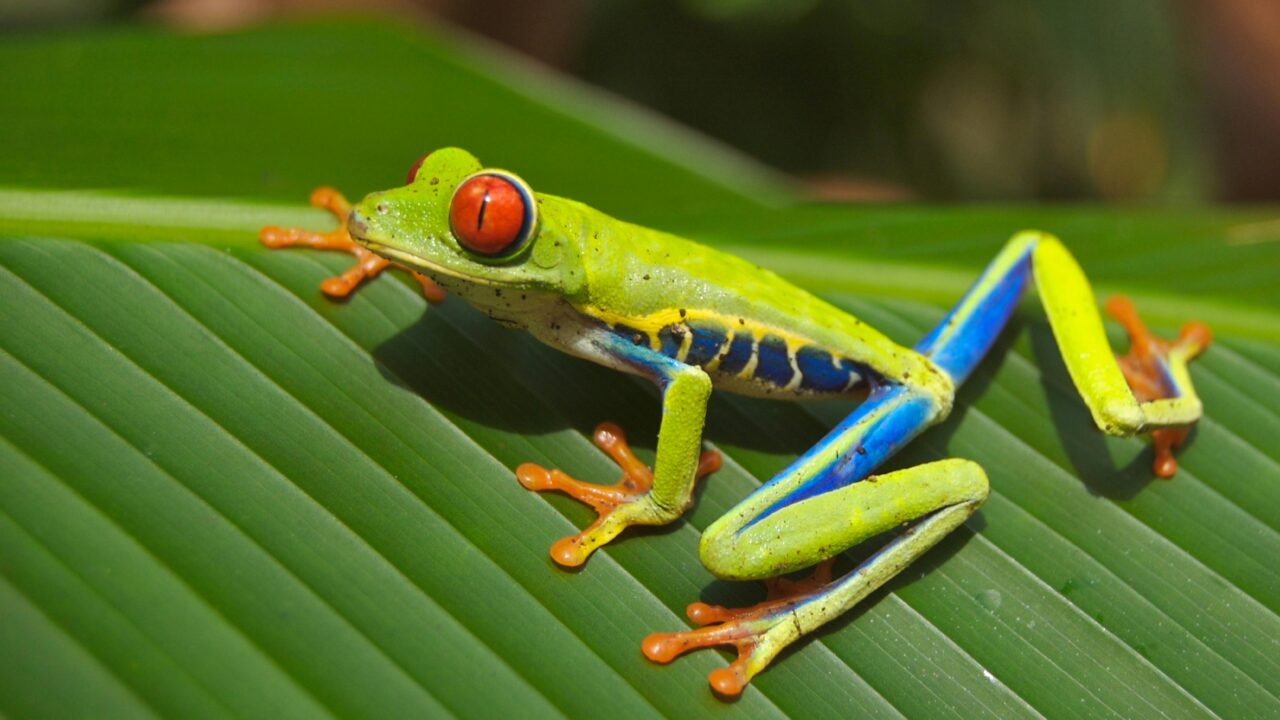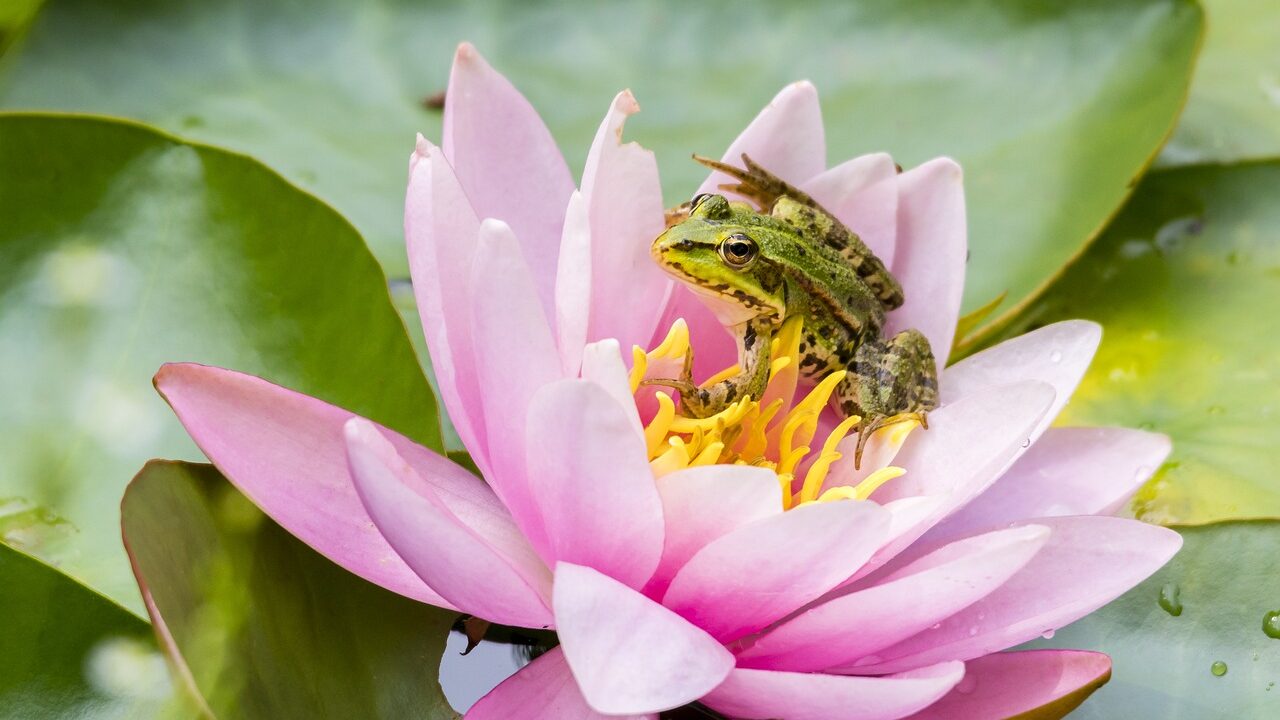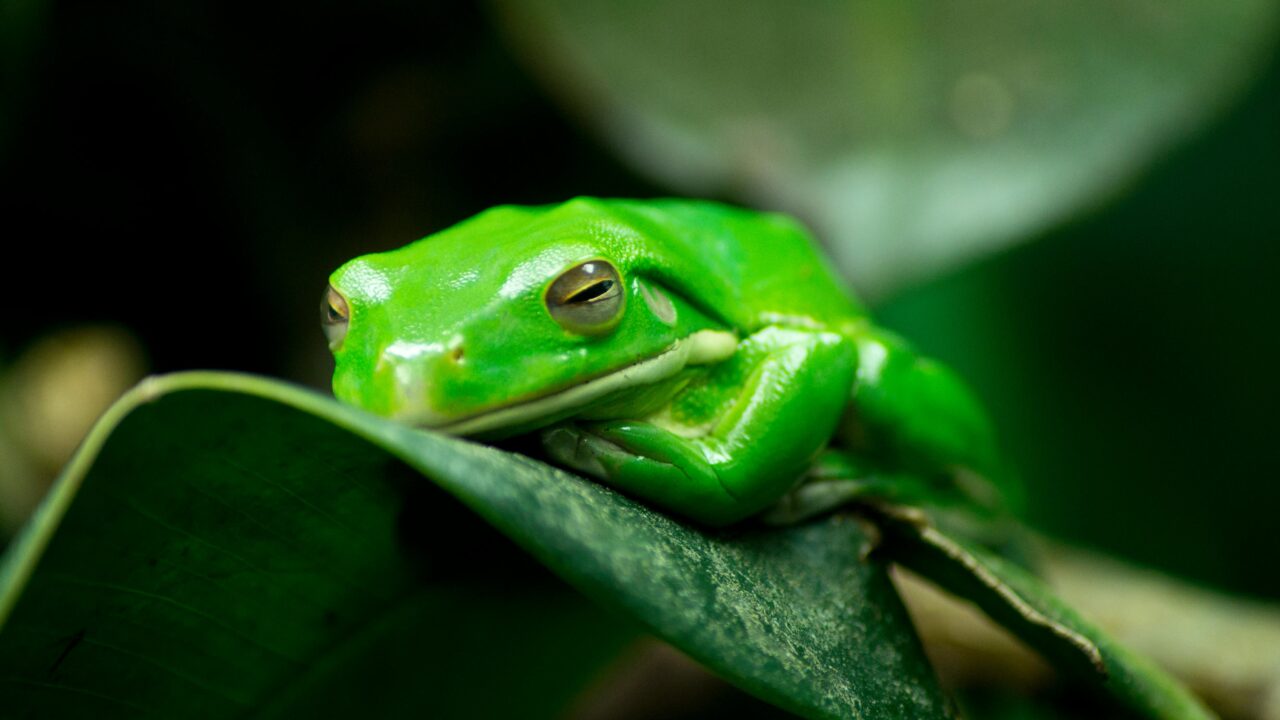Frogs are the most interesting and varied animals one can find in nature. Due to their incredible adaptability and individual characteristics, for thousands of years, humans have been interested in frog facts . From their strange croaking to impressive jumping, unique life cycles have captured our imagination, placed frogs firmly in the sphere of the ecosystem, as well as in art, culture, and science. This guide will take you through the anatomy of frogs, their life cycle, their importance in nature, and fun facts that make them truly special.
The Frog and the Nightingale

The Frog and the Nightingale is a story that captures the essence of vanity and the consequences of not valuing one’s unique qualities. The fable starts with a frog who boasts of his loud croaky voice and says he is the best singer in the pond. Then, a nightingale comes along and enchants everyone with her sweet, melodic voice. The frog, who was jealous and proud, decides to teach the nightingale how to sing like him.
He makes her mimic his gruff voice, and initially, she feels flattered with this change, but that is what ultimately leads her to her downfall. The moral of the story lies in the fact that the thing that makes us unique should be cherished and not the pressure that makes us seek to become like others’ expectations. It’s a story of being deceived and led astray by flattery and rivalry. That reminds us to have great regard for self-esteem.
Frog Dress
Frog costumes are worn by children and adults alike especially at parties and Halloween festivals. They have bright green costumes, often with web hands, large eyes, and cute smile. The costumes range from full-body onesies, frog hoods with dresses, and headbands with frog ears to a simple accessory.
Frogs are cute; the costume is fun to play around in and brings out all sorts of fun and creativity, so this costume is popular among kids at costume parties. For adults, the frog dress can symbolize a fun and carefree spirit that is perfect for themed events or parties where everyone wants to be light-hearted. Whether it is for school play or festive celebration, frog outfits are always a go-to choice to add fun and humor easy pet to care .

Frog Heart
Understanding the anatomy of a frog’s heart can be helpful in understanding how such amphibians survive in aquatic and terrestrial environments. The frog heart has three chambers: two atria and one ventricle. The right atrium receives deoxygenated blood from the body and sends it to the ventricle.
The left atrium receives oxygenated blood from the lungs and also sends it to the ventricle. The ventricle will pump blood to both the lungs and the rest of the body. The system, due to this mixing, can take up to some amount of oxygenated blood and deoxygenated blood as a frog is likely to survive under both high and low oxygen concentrations. The circulatory system adapts the lifestyle of being an amphibian in relation to life both in and out of water. A frog’s ability to breathe through its skin also contributes much to its oxygenation, especially when it is underwater low maintenance pet to care.

Rope Frog Ninja Hero Mod APK
An interesting ride for all the mobile game players looking for action and adventure is Rope Frog Ninja Hero Mod APK. In the game, you play a role as a superhero frog who swings from city to city with ropes to battle crime and accomplish different missions. What is more tempting about the mod version is that it has unlimited in-game currency so you can easily indulge in the gameplay without being interrupted.
Explore the open world, interact with different activities, fight challenging obstacles, and beat up enemies as you venture through various environments. Rope Frog Ninja Hero promises hours of entertainment, considering its dynamic gameplay, awesome graphics, and a fun and quirky main character for all who love superhero and action-packed games easy to care.
The Life Cycle of a Frog: A Journey of Metamorphosis
The life cycle of a frog is an awe-inspiring process of transformation known as metamorphosis. It starts when a female frog lays her eggs in water. After several days, the eggs hatch into tadpoles that are surrounded by a gelatinous substance. They breathe using gills and swim with their tails, fully adapted to living in water.
Their legs begin to develop as they grow, and their tail shortens gradually in what is called the “tadpole with legs” stage. Eventually, the tail is reabsorbed, and the tadpole becomes a froglet that looks like a young frog but with proportionately smaller limbs. Gradually, it matures into a fully-grown adult frog that can survive in land and water. That’s the interesting journey in frogs and a proof that these creatures are one of the most successful evolutionary changes ever made easiest to care for .

Drawing a Frog for Children
This can be an educational and fun way to draw a frog for the kids. Begin with basic shapes like circles and ovals that will be the frog’s body. Include a bigger circle for the head and smaller circles for the eyes. Join all the parts with curved lines, which will be the outline of the body.
Add details like the mouth, legs, and webbed feet for the kids to finish the drawing. To make the drawing more playful, encourage them to add unique features like a frog’s tongue or a lily pad for the frog to sit on. Once the drawing is complete, children can use crayons or markers to color the frog with green, yellow, or even blue shades. This activity helps improve motor skills, boosts creativity, and allows kids to learn more about animals while having fun.

Reproductive System of Female Frog
The female frog reproductive system is designed to make egg production easy and smooth fertilization. A female frog possesses ovaries: the organs where eggs are formed. After the eggs are ready, they are transported by oviducts: tubes that carry eggs from the ovaries out of the frog’s body.
Males frog release their sperms onto the eggs during the mating season in a process called external fertilization, thus enhancing the survival chances of eggs since they will be fertilized in their natural habitat. Frogs lay hundreds to thousands of their eggs in water and thereafter will ensure that a few will reach adulthood. Reproduction is an important method of ensuring that there are healthy populations of frogs and they do not lose genetic diversity.
Frog Circulatory System

A frog circulatory system is specially designed according to its environment, which includes water as well as land. A frog heart is a specialized three-chambered organ with two atria and one ventricle. This mixes oxygenated and deoxygenated blood, which is less efficient than a four-chambered heart but works just fine for amphibians.
Blood is pumped from the heart to the lungs to pick up oxygen and then off to the rest of the body. Frogs, too, can absorb oxygen through their skin, making this a vital adaptation in their semi-aquatic way of life. This system also ensures that frogs get enough oxygen to be active both in the water and on land.
Frog Video Viral on Twitter
Frog videos are also currently trending online, especially on sites such as Twitter. The video clips are normally of frogs jumping or playing; sometimes, they engage other animals. The clip is cute and quite riveting. It can become viral overnight with millions of views and likes.
People just love to share funny and cute frog moments with their friends and followers. These videos usually feature frogs eating, hopping around, or just relaxing in their natural environment. They give us the easy-to-access comfort of forgetting about the problems that plague our daily lives while reminding us of the beauty in nature. Whether it is a frog that surprises the audience with a jump or one that has an amusing expression, these clips bring joy to audiences around the globe.
Life Cycle of Frog Diagram

A life cycle diagram of a frog is helpful in visualizing the metamorphosis process. The diagram usually starts with the eggs shown floating in water and progresses to tadpoles which have tails and gills. The next stage involves tadpoles with legs, where the legs begin to form, but the tail shrinks.
Froglet is a smaller version of an adult frog; finally, the adult frog displays the fully grown amphibian, which can live either in water or on land. This visual display has helped learners understand the process of metamorphosis as well as appreciate the change of frogs from birth to adulthood.
True Frog
True frog belongs to the Ranidae family and one of the most known species in it. Like American bullfrog, European common frog. Frogs are known with moist skin and long hind legs and thus are jumpers at long distances. They possess a very unique adaptation enabling them to live in both water and on land. Their skin allows them to absorb water and oxygen. They vary in habitats like ponds, marshes, and forests. True frogs play a significant role in the ecosystem; they help control insects, and they are prey for bigger animals.

Frog's Arterial System
The frog has an adapted circulatory system according to its semi-aquatic lifestyle. Frogs have a three-chambered heart, consisting of two atria and one ventricle. This system has some partial mixing of oxygen-rich and oxygen-poor blood and, although not as effective as the four-chambered heart of mammals, it suffices for the frogs due to their aquatic and terrestrial living styles.
The aorta carries oxygenated blood from the heart to the body, which provides the body with energy and nutrients to enable it to move and function in other ways. Meanwhile, the pulmonary artery carries deoxygenated blood from the body to the lungs, where oxygen is taken and carbon dioxide expelled. Frogs are special in that they can even absorb oxygen through their skin, making them always oxygenated even if they are in water or damp surroundings. That is why you often find them resting in or near water.
Combining lung and skin absorption helps the frog endure in multiple environments: by being able to breathe with their lungs and absorb substances from the skin itself. Whether hopping into a forest or climbing on trees to swim into a pond, survival in any given condition makes the circulatory system just spectacular-an amazing display of endurance as well as versatility from living organisms such as frogs.
Diagram of a Frog Digestive System

This whole system of a frog is generally inclined towards breaking down the diet comprised dominantly of insects and preys. In other words, the mouth starts the digestive system. Food is passed through it, then digested in the stomach. There, digestive enzymes break it down.
Finally, it moves to the small intestines for nutrient absorption. The large intestine is where the water absorption and forming wastes take place. The final point is the cloaca where the waste leaves the body. This system allows frogs to efficiently get rid of all the nutrients they require from their food.
The Anatomy of a Frog: Amazing Frog facts
One’s knowledge of the anatomy of a frog can give one insight into their versatility and general lifestyle. Their A frog’s heart has three chambers: two atria and one ventricle. Here, oxygen-rich and oxygen-poor blood mix. This setup is less efficient than a four-chambered heart, yet it suits amphibians well. Additionally, frogs have permeable skin. This allows them to absorb oxygen directly from their environment, particularly in water. Their muscular legs are for powerful jumps, making them one of the best jumpers in the animal kingdom. These features make frogs perfect for their semi-aquatic lifestyle. They thrive in both water and on land easy to care for.
Frog Habitat and Adaptations Suction cups are present on the feet of tree frogs for climbing up trees; some have webbed feet to swim more easily. Fragile and responsive, amphibian skin acts as a barometer for ecosystem wellbeing . These creatures are living gauges. Their delicate bodies reflect shifts in their habitats.. If the population of frogs starts to decline, then it might be a symptom of pollution or habitat loss. Importance of Frogs in Ecosystems
Frogs are an important component of ecological balance

They are both predators and prey, controlling the population of insects and being a source of food for larger animals such as birds, snakes, and fish. Frogs regulate disease-carrying mosquitoes. They also maintain aquatic ecosystems. If they are found in an ecosystem, it means that it is healthy and well-balanced. Biodiversity can only be achieved by preserving frog habitats and making sure that the balance in nature is maintained. Fun and Interesting Frog Facts
Frogs are not only interesting but come with some surprising facts that might amaze you:
Frogs can survive in different climates, such as tropical and temperate regions.
Some species, like the wood frog, can survive when frozen in winter and thaw in spring.
Frogs can jump over 20 times their body length, making them one of the best jumpers in the animal kingdom.
Some frogs change color to blend into their surroundings for defense.
The Paedophryne amauensis is the smallest frog in the world and is about 7.7 millimeters long.
These facts prove just how adaptable and unique frogs are, making them an interesting subject to study and admire.
Conclusion: Frogs The World of Frogs
An understanding of how their anatomy works, from the specific heart design to efficient systems for circulating and digesting nutrients, helps us better appreciate the perfect adaptation these amphibians have for living in water or on land.
Whether you find frog drawings funny and creative, or you want to understand a role of frogs in the environment, or you discover fun facts through viral videos, somehow frogs just seem to take our imaginations and strike an interest in learning more. There is importance placed on how adaptable and resilient they are. They bring us back to the size of nature and the impact of living in such magnificence. As the years pass, frogs are always changing, and they inspire different people.
As we continue to learn more about frogs, it is quite natural to protect their habitat in the future. Frogs play a very significant role within our ecosystem; they can easily control the population of the insects and serve as environmental health indicators. To enable informed choices for conserving the habitats and further enabling frogs to survive from this generation to the next will depend on better knowledge about frogs and appreciating them for their value.
FAQ FOR FROGS
Do frogs like to be petted?
Frogs usually do not like being petted. Their sensitive skin absorbs oils, lotions, and bacteria from human hands, which are harmful to them.
10 Facts About Frogs
Frogs drink water through their skin so they do not need to drink.
They live on every continent except Antarctica.
Frogs have big bulging eyes that give them a wide field of vision.
Frogs have a wide range of croaks, clicks, and whistles to communicate.
They are carnivorous and feed on insects, small animals, and even other frogs.
Frogs are very good jumpers, jumping 20 times their body length.
Their skin is camouflage or toxic to the predators.
Frogs begin life as tadpoles in water before metamorphosing into adults.
Frogs play a vital role in ecosystems as both predator and prey.
Frogs are sensitive to environmental changes, thus acting as indicators of ecological health.
Do frogs drink water?
No, frogs do not drink water in the conventional sense. They absorb water directly through their skin.
What does a frog require to survive?
Frogs require:
Moist environment
Live prey such as insects
Clean water or damp soil for hydration
Proper shelter such as vegetation or burrows
Suitable temperatures and humidity levels
Frogs as pets
Frogs can be great pets but need special care. They need a clean, temperature-controlled terrarium. It must have proper humidity. Their diet is live insects.
Frogs for sale
Frogs can be bought in pet stores or from breeders. Popular pet species include African Dwarf Frogs, Pacman Frogs, and Tree Frogs. Always buy from a reliable source to avoid supporting illegal wildlife trade.
Frog species
There are over 7,000 known frog species, including the Poison Dart Frog, Bullfrog, and Red-Eyed Tree Frog.
Frog family
Most frogs are members of the Ranidae family, which include most common frog species. Other families include Bufonidae (toads) and Hylidae (tree frogs).
5 traits of frogs
Moist, permeable skin.
Long, powerful hind legs used for jumping.
Bulging eyes for wide range of vision.
Egg fertilization occurs outside and in water.
They have ability to breathe through their lungs and skin.
Frog order
Frogs are a class of Anura, meaning "tail-less."
Scientific name of frog
The scientific name of a typical frog is Rana temporaria. Scientific names are different for different species.
Classification of frog from Kingdom to Species
Kingdom: Animalia
Phylum: Chordata
Class: Amphibia
Order: Anura
Family: Different (e.g., Ranidae)
Genus: Different (e.g., Rana)
Species: Different (e.g., Rana temporaria)

